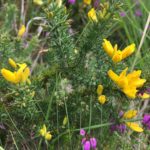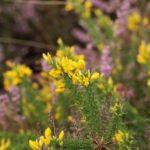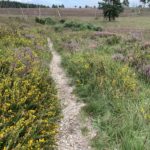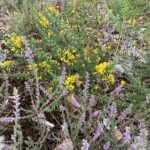Dwarf Gorse

Back Cross-leaved Heath Common Heather Bell Heather Common Gorse Dwarf Gorse Sundew
DWARF GORSE
Ulex minor
A much smaller plant than Common Gorse. It only usually grows up to 30 cm tall – but has been observed growing up to a metre. Like Common Gorse, it is a member of the pea family. Its leaves are spines, growing around 1 cm long. They are smaller and denser than Common Gorse. The flowers are 1-2 cms long and it flowers in late summer.
- Dwarf Gorse by Warden Flo
- Dwarf Gorse by Warden Tim
- At the end of August, when the Common Heather is in flower, the gorse that’s also flowering will be Dwarf Gorse
- Dwarf Gorse flowering amongst Common Heather in late July
[Click on the thumbnails to open]
Where/when to find it
Unlike its close relatives, it is much more restricted to nutrient poor soils – such as lowland heathland. A few plants are found elsewhere. but it is mostly found in southern and south eastern England.
Adaptations
Much like other gorse species, Dwarf Gorse’s sharp spiny leaves help make it less palatable to certain grazing animals. Its spines, however, are much softer than its close relatives, so it is more susceptible to being eaten. Like other members of the pea family, it has a symbiotic relationship with bacteria that live in root nodules. The bacteria can “fix” nitrogen gas from the air – turning it into ammonia or amino acids. They provide their host with the excess in return for the plant providing them with the products of photosynthesis. This gives the plant an advantage in soils with low nitrogen levels.
Rarity
While not considered threatened, this dwarf shrub has suffered from habitat loss and is sensitive to encroachment from taller scrub species.
Read more
On Plant Life’s website: Gorse
#MoreThanJustNightjars




